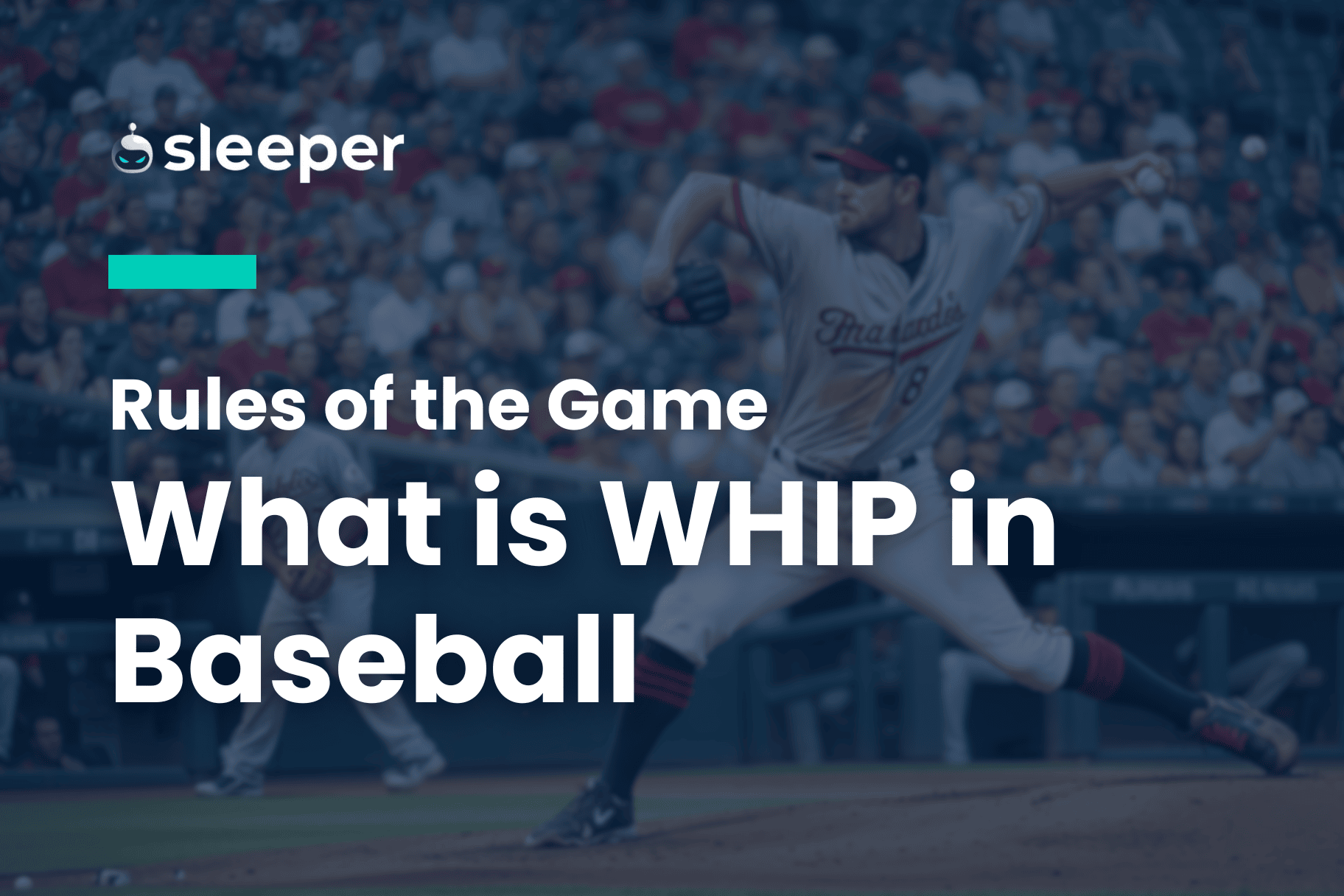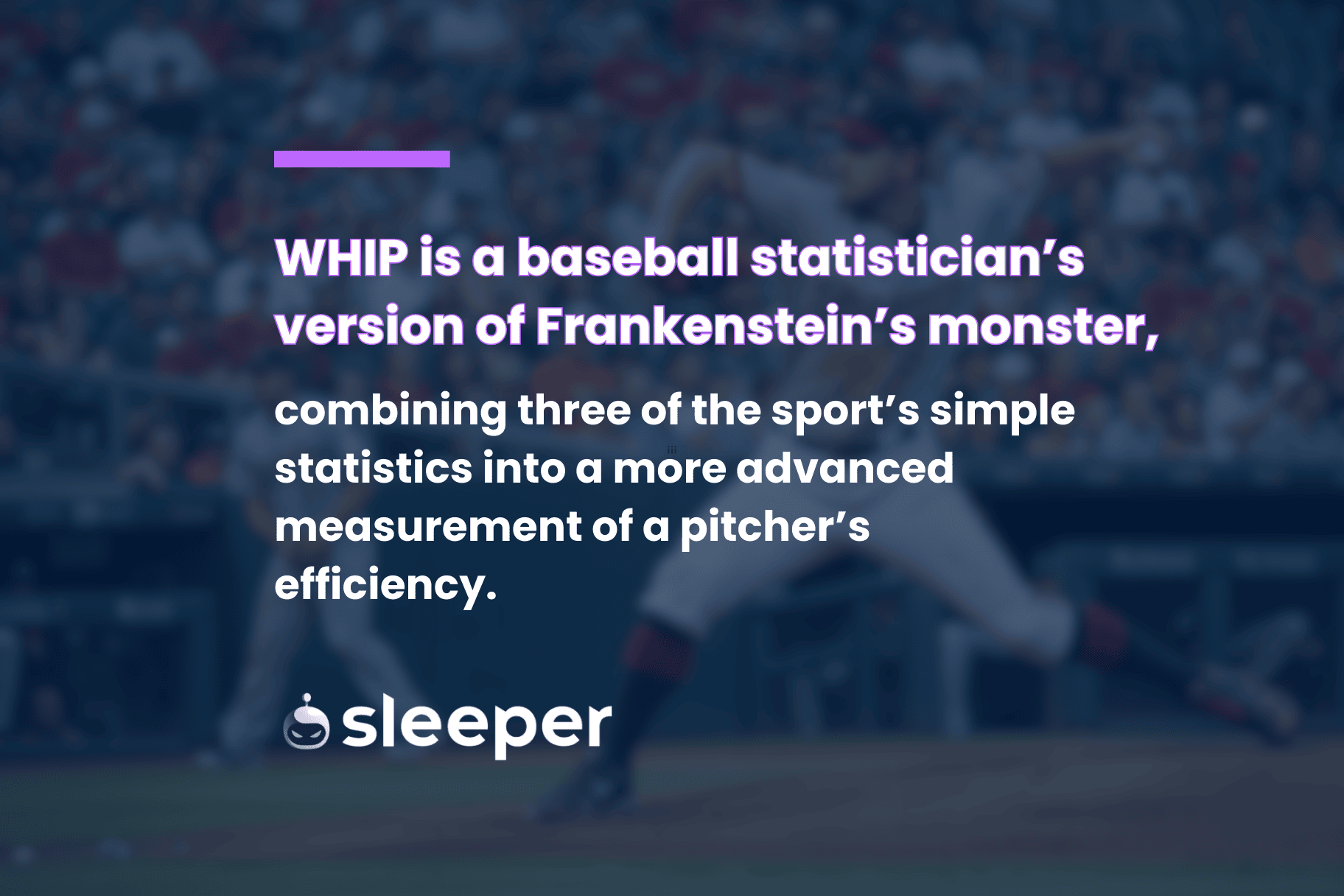Before Indiana Jones made whips cool, WHIP was already starting to take Major League Baseball by storm. What exactly is WHIP and how does it impact fantasy baseball?

What Is Walks Plus Hits per Inning Pitched (WHIP) in Baseball?
Walks plus hits per inning pitched, aka WHIP, is one of the OG sabermetric statistics in Major League Baseball.
Invented by rotisserie league fantasy baseball creator Daniel Okrent in 1979, WHIP still has a ton of value in today’s game, and not just from a fantasy perspective. WHIP is just part of a pitcher’s stat line now, alongside metrics like strikeout rate (K/9) and earned run average (ERA), telling you a little something about the pitcher’s performance to that point in the season.
If WHIP is a foreign concept to you, though, don’t worry. We’ll walk you through the fairly simple calculation, explain what it’s good for in evaluating pitchers and touch on some of the best WHIP seasons/careers in MLB history.
What is WHIP and How Is It Calculated?
WHIP is a baseball statistician’s version of Frankenstein’s monster, combining three of the sport’s simple statistics into a more advanced measurement of a pitcher’s efficiency.
The three simple statistics are:
- (W) Walks allowed: Number of times a pitcher gives a batter a free pass to first base by way of four balls in a single plate appearance.
- (H) Hits allowed: Number of times an opposing batter records either a single, double, triple or home run.
- (IP) Number of Innings Pitched: Sum of outs recorded by a pitcher, where each out counts as one-third of an inning pitched.
Once you have those three numbers, just follow the instructions of the acronym: W plus H per (divided by) IP.
A few things to note before we continue:
First and foremost, when calculating WHIP on your own, keep in mind that any time you see a .1 IP in a box score, it’s actually, mathematically, .3333 IP. Similarly, .2 IP is actually .6667 IP. For example, if a pitcher goes 4.2 IP and allows five hits and two walks for a W+H numerator of seven, his WHIP for the day was 1.50 (7 divided by 4.6667) and not 1.66 (7 divided by 4.2).
Second, WHIP is solely interested in walks and hits. It does not care about runners who reach base because of an error, catcher’s interference, a fielder’s choice, a passed ball on strike three or even a hit by pitch (HBP).
Why HBPs are still excluded from WHIP will never make sense, though. Errors, sure. Those aren’t the pitcher’s fault. But an HBP is effectively the same thing as a walk — a mistake made by the pitcher and the pitcher alone. However, because HBPs weren’t part of the newspaper box scores when Okrent invented WHIP, it wasn’t originally part of the equation and has been left thus ever since. (That’s good news for Randy Johnson, whose career WHIP of 1.17 would climb to 1.22 if it counted his 190 HBPs.)
Lastly but notably, WHIP couldn't care less about how impressive a hit was. A bunt single to lead off the game or a lazy pop fly that turns into a double because the outfielder loses it in the sun counts just the same against a pitcher’s WHIP as a 500-foot, walk-off grand slam does.
Any stat used in a vacuum is going to have limitations, though, and it’s hard to argue with how good of a job WHIP does at conveying how well (or poorly) a pitcher does at keeping baserunners to a minimum.

What Is a Good WHIP in Baseball?
On an annual basis dating back to 2011, MLB’s league-wide WHIP has consistently hovered in the range of 1.27-1.34. An average, straight-Cs-on-a-report-card pitcher, then, would be expected to have a WHIP of 1.30.
Sticking with that report-card theme, every step of 0.05 away from 1.30 is essentially a grade change. A 1.25 WHIP is slightly better than average for a C+, whereas a pitcher with a 1.35 WHIP is a C- in that department.
Keep following that bell curve in each direction and an A+ WHIP is anything lower than 1.00, while a failing WHIP is anything north of 1.50.
That’s a general guide for a full-season WHIP in MLB’s current state, though. For career numbers, 1.10 or better is darn good; however, for a single start, you’ve got to be down below a 0.50 WHIP if you want anyone to even notice.
Players with the Lowest WHIP in MLB History
Entering the 2024 season, there were only four pitchers in MLB history who had logged at least 500 innings pitched with a career WHIP below 1.00: Closers Kenley Jansen (0.96) and Craig Kimbrel (0.99), oft-injured ace Jacob deGrom (0.99) and an ancient Hall of Famer by the name of Addie Joss, who had a mark of 0.97 in his nine seasons with the Cleveland Naps in the early 1900s.
Increase the minimum threshold to 2,500 innings pitched and the only pitchers with a WHIP of 1.05 or lower are Pedro Martinez (1.05), Clayton Kershaw (1.00) and another long-forgotten Hall of Famer from more than a century ago, Ed Walsh (1.00).
If we’re talking single season as opposed to career, though, better get a microscope out to see some of these numbers.
In Pedro Martinez’s legendary 2000 campaign, he allowed just 128 hits and 32 walks in 217.0 innings pitched for an all-time minuscule WHIP of 0.737.
Kenta Maeda (0.75) and Trevor Bauer (0.79) both had a sub-0.8 WHIP in 2020, though it comes with a major asterisk given they each made just 11 starts during that 60-game, pandemic-shortened season.
The more legitimately remarkable full-season numbers in that same vicinity are Walter Johnson’s 0.78 WHIP in 1913, Greg Maddux’s 0.81 WHIP in 1995 and Justin Verlander’s 0.80 WHIP in 2019.
Let’s also make sure to at least mention Mariano Rivera. If you take out the rookie season in which the greatest closer of all-time quickly established that he wasn’t meant to be a starter, Rivera had a 0.972 WHIP over the other 18 seasons of his career — during the regular season, that is.
Postseason Mariano Rivera was a WHIP God, allowing 86 hits and 21 walks in 141 innings pitched for an outrageous 0.759 WHIP.
WHIP in Fantasy Baseball
In most season-long fantasy baseball leagues, whether it’s a rotisserie or head-to-head format, WHIP is one of the standard pitching categories. If your pitchers post a collective WHIP lower than your opponents’ for the week, you win that category.
WHIP doesn’t explicitly show up in scoring for Daily Fantasy Sports baseball pools, but its elements certainly do. You’ll typically gain points for each out recorded by one of your pitchers and lose points for each hit or walk they allow.
The unfortunate truth about a pitcher’s WHIP, though, is that it can wildly fluctuate from one start to the next.
Gerrit Cole led the majors with a 0.981 WHIP in 2023, but he had six starts at 1.50 or more as well as six starts below 0.50. And one of those bad starts came in mid-September against a considerably sub-par Pirates offense on an off night that surely swung a few fantasy playoff matchups.
By and large, though, an MLB pitcher’s WHIP is a better indicator of future successes/failures than earned run average (ERA). The two usually go hand-in-hand, in that a pitcher’s best ERA years are almost always also his best WHIP years.
See also: How Fantasy Baseball Scoring Works
Frequently Asked Questions
Is it better for pitchers to have a higher WHIP or a lower WHIP?
Lower. In a perfect game, a pitcher would have a WHIP of 0.00.
Which is more important, WHIP or ERA?
At the end of the day, keeping runs to a minimum is way more important than keeping baserunners to a minimum. Case in point, in 2023, Blake Snell (1.19 WHIP, 2.25 ERA) won the NL Cy Young Award while Spencer Strider (1.09 WHIP, 3.86 ERA) didn’t get a single first-place vote, despite leading the majors in both wins (20) and total strikeouts (281). Strider simply allowed too many runs, even though he did a better job of keeping the bases clear than Snell did.
To reiterate a point just made in the section on fantasy baseball, though, WHIP is a better gauge of a pitcher’s efficiency and how likely it is that he will continue to pitch at that level of excellence (or mediocrity).
What are the biggest limitations of using WHIP?
It’s weird/limiting that the type of hit allowed is wholly irrelevant to WHIP, and that neither FanGraphs nor Baseball Reference readily tracks how many doubles, triples or total bases a pitcher allows over the course of a season.
We are obsessed with slugging percentage and exit velocity on the hitting side of baseball stats, but with pitchers … meh, whatever, hits allowed are hits allowed?
While there are more advanced pitching statistics out there that account for both the type and quality of hit allowed, the beauty of WHIP is the simplicity of the formula that you now have memorized just by knowing what WHIP stands for.
Get Cracking With Sleeper’s Baseball Games
There you have it: WHIP in a nutshell.
It doesn’t singularly tell you the story of how good or lucky a pitcher has been quite as well as Wins Above Replacement (WAR), expected fielding-independent pitching (xFIP) or expected weighted on-base average (xwOBA) can, but it’s a mighty fine ‘advanced’ statistic that you can actually calculate on your own.
Now that you know a bit more about one of the primary statistics used in fantasy baseball, you might want to start playing it. If so, give Sleeper a try. The app provides a top-notch user experience, and its fantasy offerings are plentiful, from breaking news and alerts, to Sleeper Picks, a paid-entry DFS contest in which you pick whether players will exceed or miss the mark on their projected stats for that day.




